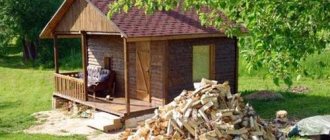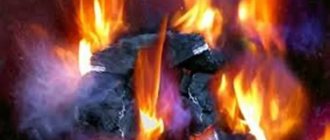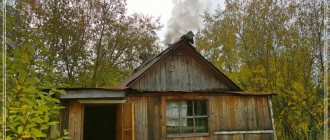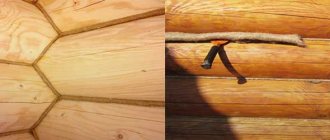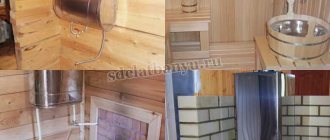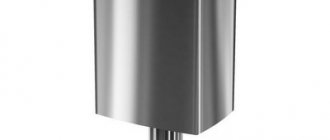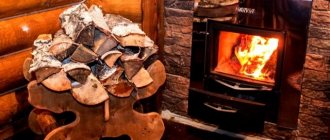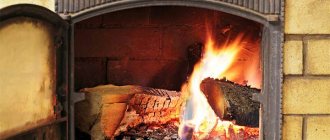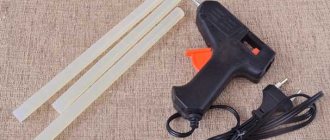The queen of the sauna stove loves it when it is heated with good, not rotten wood. Then the heat in the bath is excellent! Is it possible to heat a stove in a bathhouse with coal?
It is impossible to answer such a question in one word. For this reason, I decided to write a separate article in which I will try to answer this question.
They heat the bathhouse with coal where firewood is very rare and in short supply...
In central Russia there are practically no forests suitable for felling. Gardens, groves, plantings, lindens, oaks, apple trees, cherries, pears, only an unruly person would use such beauty of nature as firewood!
Moreover, it will not be possible to heat a bathhouse perfectly with just an armful of firewood...
This is where the well-known fuel material coal comes to the rescue. After all, burning coal is an economical, effective way to heat any premises.
Living in the Far North, we didn’t know what it was to burn stoves with coal. But for example, in the Belgorod region (where my mother is from), coal in the stove was commonplace. Now, of course, gas has been installed in the houses, and this tradition is becoming a thing of the past.
But, my story about how to heat a stove with coal will be based on my memories and the stories of my grandmother. So…
In order to melt coal in the stove, a small amount of firewood is needed. Without firewood it is impossible to light coal; matches are indispensable. I personally tried to light a coal stove with a match - it was a futile effort.
Wood chips are essential! When the wood is hot and the flame is dancing in the stove, it’s time to add coal. But, of course, not a whole bucket at once, but only a little, and when the coal flares up, add a new portion.
Firing a stove with coal is different from heating it with wood. In order to speed up the combustion process of coal, it is necessary to stir it with a poker, this way we give a new portion of air to the fire. Everyone knows that without air, fire will not dance.
Remember that you need to start stirring the coal after it is well lit, after about 15-20 minutes. Otherwise you risk putting out the fire.
As a portion of coal burns out in the stove, you need to add a new one. As far as I remember, a bucket of coal was enough to heat a small room in the house.
It is also worth noting that the heat in your stove depends on the quality of the coal. Unfortunately, coal is not always of high quality. Fine coal and coal dust not only do not provide any heat, but can also extinguish the stove.
Therefore, before putting coal into the oven, it is always sifted. This is done through a special device - a sieve. Pebbles that remain after sifting and are suitable for filling in the oven.
Are there any special features when firing a wood-burning stove in a coal bath?
The quality of bath procedures largely depends on the correct preparation of the steam room. The art of heating sauna stoves has been passed down in Rus' from generation to generation. Preparing a white bath has its own characteristics. First of all, you need to choose the right fuel for the stove. The vast majority of heaters are fired with wood. The greatest effect is achieved from the use of birch or larch firewood. In winter, you can add oak firewood. When burned, birch firewood quickly heats up the heater stones and produces less carbon monoxide than other firewood. When burned, larch firewood produces not only a lot of heat, but also a large amount of carbon monoxide. Therefore, an accurate determination of the moment of closing the valve is required. If the valve is closed too early, carbon monoxide will appear in the room, and closing it too late will cause the stove to cool down. You need to know that the valve can only be closed if there are no blue coals in the firebox, otherwise you can get carbon monoxide poisoning. For proper combustion, logs should be selected of the same length and thickness, and their number depends on the size of the firebox . The second portion of firewood is placed under the condition that the first portion is completely burned. But the amount of firewood in the second portion will be smaller, since a layer of hot coals will already be formed in the combustion space. If the stone backfill is heated sufficiently, you should not wait for the firewood to burn completely, but rather steam it. If the firewood burns out and the bath attendant starts watering the stone backfill, the temperature in the furnace firebox decreases and a new portion of firewood will be required. Do not throw painted wood, plastic, roofing felt, bitumen and other materials that emit toxic substances into the firebox. Toward the end of the firebox, you can throw several aspen logs into the stove, which form a long red-blue flame that destroys soot. It is better to remove unburned logs after bathing procedures from the firebox and cool them in the yard in a metal “stewer” with a lid. If there is no birch firewood, the bathhouse is heated with pine, spruce, cedar firewood, and in treeless regions peat and coal are used. However, when burning, coal produces more heat than wood, so the furnace firebox must be designed for its use. To do this, it is laid out from refractory bricks. Do not overheat the stove - otherwise cracks will appear in the lining and masonry. If the design of the furnace requires the furnace to operate on hard coal or anthracite, the valve should be installed in such a way that it does not close tightly and leaves a gap of at least 10-15 mm, or several holes with a diameter of 10 mm can be drilled in it. This will protect bath attendants from carbon monoxide poisoning. Lighting a stove on coal or anthracite has its own characteristics. First, light the stove with small wood. A 50-60 mm layer of coal is poured onto them. After the coal burns well, the backfill thickness is adjusted to 150 mm, but no more, otherwise fuel consumption will be uneconomical. After finishing the furnace fire, the coals that have not burned completely are raked onto the grate so that they are well blown with air coming from the ash pit. If there is no grate, then the coals are raked closer to the oven outlet. Control over the end of the firebox and the beginning of bathing procedures is usually carried out by the temperature of the stone backfill, the temperature of which should be at least 200-250°C.
The temperature of the stones is usually determined using the following method: the stones are watered with a small portion of water, the splashes of which falling on the heater should instantly evaporate. At the same time, a characteristic hissing sound appears. It should be remembered that cold water cools the stove very quickly, and the capacity of the bathhouse is sharply reduced. Therefore, in all cases of spraying the heater, it is better to use hot water. Added: 05/19/2012 09:03
Discussion of the issue on the forum:
Preparing the stove for combustion
Before heating the bathhouse, it is necessary to carry out measures to prepare the stove. Preparatory measures include:
- Thorough cleaning of the grate and ash chamber. The grate and ash pit must be carefully cleaned of remaining coals and ash;
- treating stones with clean water;
- checking the cleanliness and serviceability of the chimney.
Attention: The stove chimney must be fully ventilated to avoid the accumulation of carbon monoxide, which is dangerous to human life.
You can check the draft in the chimney using a candle flame. First you need to open the smoke damper in the chimney, as well as the vent and the firebox door. After this, you should bring a lit match to the firebox. It is necessary to monitor the direction of the flame. So, if the flame is drawn into the chimney, then the passage of smoke is ensured.
If the flame does not move, then there is a danger of the chimney becoming clogged, which leads to a decrease in draft. In this case, the stove owner must ensure that the chimney is pre-cleaned.
Other publications in the “Baths” section. Saunas. Swimming pools"
It is quite difficult to give specific advice without knowing the installation diagram for the equipment of a given hot tub and spa pool. From an engineering point of view, it is clear that when filling the bath with water, the pump supplying water to the massage nozzles must also be filled with water. If this does not happen, the pump will be r.
Many dry mixtures (adhesives) are now produced for decorative lining of swimming pools. They are intended for gluing various ceramic and mosaic tiles, natural stone tiles, and porcelain stoneware. The following dry mixtures can be used: BIRSS GIDROFIX 27C and GIDROFLEX 27C, CONCOLIT 640.
Nowadays, many dry mixtures are produced for waterproofing work, including those that can be used for sealing and waterproofing swimming pools. Such mixtures include: POLYMIX GS, UNIS BARRIER and POOL, WATERPROOFING M600, PLITONITE GIDROSTOP and GIDROELAST, POBEDIT-GIDROSTOP, SUPE.
Source
Is it possible to heat a stove in a bathhouse with coal?
The queen of the sauna stove loves it when it is heated with good, not rotten wood. Then the heat in the bath is excellent! Is it possible to heat a stove in a bathhouse with coal?
It is impossible to answer such a question in one word. For this reason, I decided to write a separate article in which I will try to answer this question.
They heat the bathhouse with coal where firewood is very rare and in short supply...
In central Russia there are practically no forests suitable for felling. Gardens, groves, plantings, lindens, oaks, apple trees, cherries, pears, only an unruly person would use such beauty of nature as firewood!
Moreover, it will not be possible to heat a bathhouse perfectly with just an armful of firewood...
This is where the well-known fuel material coal comes to the rescue. After all, burning coal is an economical, effective way to heat any premises.
Living in the Far North, we didn’t know what it was to burn stoves with coal. But for example, in the Belgorod region (where my mother is from), coal in the stove was commonplace. Now, of course, gas has been installed in the houses, and this tradition is becoming a thing of the past.
But, my story about how to heat a stove with coal will be based on my memories and the stories of my grandmother. So…
In order to melt coal in the stove, a small amount of firewood is needed. Without firewood it is impossible to light coal; matches are indispensable. I personally tried to light a coal stove with a match - it was a futile effort.
Wood chips are essential! When the wood is hot and the flame is dancing in the stove, it’s time to add coal. But, of course, not a whole bucket at once, but only a little, and when the coal flares up, add a new portion.
Firing a stove with coal is different from heating it with wood. In order to speed up the combustion process of coal, it is necessary to stir it with a poker, this way we give a new portion of air to the fire. Everyone knows that without air, fire will not dance.
Remember that you need to start stirring the coal after it is well lit, after about 15-20 minutes. Otherwise you risk putting out the fire.
As a portion of coal burns out in the stove, you need to add a new one. As far as I remember, a bucket of coal was enough to heat a small room in the house.
It is also worth noting that the heat in your stove depends on the quality of the coal. Unfortunately, coal is not always of high quality. Fine coal and coal dust not only do not provide any heat, but can also extinguish the stove.
Therefore, before putting coal into the oven, it is always sifted. This is done through a special device - a sieve. Pebbles that remain after sifting and are suitable for filling in the oven.
Features of heating a coal bath
Coal does not have a special aroma, the specific smell of burnt logs. You will never see the amazing dance of the flame as it jumps from log to log. The charm of the process of heating a bathhouse is somehow simplified and becomes a purely mechanical procedure.
It should also be noted that coal ash is much more toxic than wood ash. The oven should only be cleaned after it has cooled down. In this case, the ash will not smoke and will not pollute the air you have to breathe.
When a sauna is heated with coal, the sauna steam and its quality change. Coal steam is heavy and wet. Most often, a dry bath heated with coal does not work. But, even if the result is a dry bathhouse kingdom, it will in many ways be inferior to the one heated with firewood. But this is purely my personal opinion...
However, all the shortcomings of a coal stove are more than compensated for by the unprecedented heat! Such heat in the bath lasts for a very, very long time.
There is also such an important point as the fact that coal never burns completely in a stove. Therefore, after cleaning the stove, the combustion products are sifted through a sieve. That's what my grandfather did. Unburned coal was again used to fill the furnace.
Never heat a sauna with black coal! This is harmful to health, carbon monoxide and coal soot must escape into the chimney! After the sauna is heated and the stove mouth is free of fire, rake the coals with a poker from the heater, and after finishing the sauna ceremony, be sure to clean the stove.
In conclusion, I want to say that the stove in a bathhouse is often used to burn a wide variety of garbage and rubbish. Remember: you cannot burn anything that has served its purpose in a sauna stove. The stove turns into a source of toxic emissions, then the benefits of the bath and the therapeutic effect are out of the question.
The bath cleanses the body and pleases the soul. I don’t know about you, but after a good bath I feel light and calm in my soul. The heat of the bath and some water relieve sadness and take away worries. It’s not for nothing that they say: “After the bath I was born again!”
I will be very grateful to my readers who will share in the comments their experience and knowledge about how to heat a sauna with coal. Perhaps there are some interesting aspects of this bath heating process, share with me!
Source
How to choose?
The main selection criterion is the material used to make this stove. If it is brick, then it requires creating its own foundation and this is not the best option for baths with a small area.
Metal welded furnaces can have different sheet thicknesses. The larger it is, the more reliable the product will be.
It is worth choosing ovens in which the sheet thickness is at least 4 mm. This is the optimal indicator that allows you to maintain the lightness of the structure, protect it from mechanical damage and burnout during operation, which often leads to deformation of the structure.
It is also worth choosing ready-made options with protection against burns, because during operation their surface heats up much more than other options.
Solid cast iron stoves should be selected based on size. Here it is also necessary to take into account information about the alloy, the grade of which is used to create the structure. This can be obtained from the product manufacturer.
Should the bathhouse be heated with coal?
If there is any doubt as to whether it is better to heat a bathhouse, coal or firewood, then the answer will be unequivocal - firewood.
But there are regions where it is easier and cheaper to get coal than firewood, and you have to adapt to this type of fuel. Therefore, it is important to know how and what to watch out for when lighting a bathhouse with coal. To avoid smoke when lighting the stove with coal, it is necessary to control the permeability of the chimney and ensure good draft from it. The heat in the furnace directly depends on the quality of the coal. Fine coal and coal dust do not produce heat, but leave a lot of ash after combustion. Coal ash is much more toxic than the ash left after burning wood. After bathing procedures, you need to wait for the stove to cool down and thoroughly clean it of ash. Then, during the next kindling, the old ash will not smoke, and the air will remain clean.
The quality of steam when burning coal does not change for the better. The steam becomes heavy, humid and may not be useful for everyone. But even if, with proper watering of the heater, you get dry steam, it will be significantly inferior to steam heated with wood. When using coal, you cannot heat the bathhouse black; coal soot and combustion products must come out only through the chimney. It is not recommended to burn old items, various rubbish and garbage in a sauna stove. Because then the stove becomes a source of emissions harmful to the body and all the benefits of the bath come to naught.
But with all the disadvantages of coal kindling, one can also highlight a positive side - excellent heat that lasts for quite a long time. So the choice of fuel for a sauna stove depends on the geographic location of the sauna, the financial capabilities of the sauna attendants and the desire to truly improve your body.
Source
Choosing firewood
Firewood and a stove are the pillars on which a good bathhouse stands. And, if an unusable stove can only be broken in order to be rebuilt, then unusable firewood can always be replaced. What kind of firewood should you avoid?
“Yes, we don’t need this kind of hockey!” exclaimed legendary sports commentator Nikolai Ozerov, when Canadian professionals frantically began beating Soviet amateurs. Any self-respecting stoker has the right to say exactly the same phrase when he sees such firewood, before lighting the bathhouse:
- Railway sleepers. When dismantling and repairing railway tracks, a lot of free firewood often appears, which, greedy for free compatriots, happily drag to their native lands. Sleepers, poles and other elements of the industrial landscape are treated with protective compounds that prevent them from rotting. Burning them in a furnace leads to the sublimation of such substances and their combustion products into the internal atmosphere of the steam room, which is very fraught. Even deaths were recorded;
- Boards with traces of paintwork. The reason is the same;
- Wood with signs of destruction by fungi, the so-called rotten wood. In this case, you won’t be able to swallow chemical filth, but there will be little benefit from burning such raw materials. Wood that has been subjected to destruction by fungi and parasites greatly loses its caloric content and it is better to use suitable firewood than to heat the stove with dust, even if it is free.
Due to a number of features, the following types of wood are not entirely suitable:
- Spruce is a low-calorie fuel. With an equal volume of burned raw materials, less heat is released. Due to the high resin content, a large amount of soot is released during combustion;
- Pine - gives a high, light, but low-temperature flame. They burn out quickly and do not retain heat well. Tendency to shoot coals, which requires increased attention to avoid fire in the furnace flue space. To a lesser extent, but also clogs chimneys with soot and tar deposits;
- Poplar and aspen are lightweight firewood that produces a long flame that burns well through chimneys, but is low in calories and does not retain heat well. When constantly used to fire a stove, conifer wood must be used to clean chimneys naturally, using the power of flame.
What we need
This includes firewood of the highest quality category. It is with these that it is most pleasant to decide how to properly flood a bathhouse:
- Alder is “royal” firewood. Produces a dense, clean, consistent flame. Fully high-calorie wood, quite acceptable in terms of labor costs for manual firewood harvesting;
- Oak and ash are very valuable woods that, when burned, give off a characteristic and unique spicy aroma. High-calorie firewood that retains heat perfectly. They burn long enough and evenly. Oak splits perfectly along the grain, producing dies of standard size. They are expensive due to the value of the wood. It is possible to use wood processing waste;
- Birch is probably the best option for solving the question of how to heat a bathhouse. They provide high-calorie and high-quality fuel raw materials. When using woodworking waste, birch bark should be used with caution, due to the increased release of volatile resins deposited on the walls of chimneys. With relative cheapness and accessibility, a true classic of the genre in the making;
- Fruit firewood - like any other hardwood, produces high-quality firewood, distinguished, among other things, by a subtle spicy aroma when burned. Quite expensive. In addition, some tree species are highly durable and knotty, which makes harvesting firewood in significant volumes quite a fun process in all respects.
Features of lighting a stove with wood
Wood is considered an environmentally friendly material. Wood-burning Russian sauna stoves are chosen by most owners due to the following advantages:
· ease of installation;
Wood-burning stoves for Russian baths come in various types. It can be made of metal or brick. The advantages of a metal structure are that it is easy to install and heats up the room faster than a brick structure.
Firewood is made from various types of wood. Among the most popular are:
· from coniferous species, etc.
One of the advantages of burning wood is that the atmosphere of an old Russian bathhouse is created in the room. It promotes rest and relaxation.
The disadvantages of firewood include its high cost compared to coal. In addition, in some regions, obtaining this fuel can be quite problematic. Then bathhouse owners resort to alternative options.
Device
There are many options for coal stoves for saunas. They differ from each other in material of manufacture, dimensions and other important parameters, but have several common elements that determine their design:
- chimney;
- ash pan (or ash pan-scoop);
- pipe;
- firebox;
- heater.
Construction of a coal sauna stove
How to install the Kutkin stove correctly
Thanks to such innovations as a double screen and the use of argon welding, the overall design is quite reliable and stable. There are no additional requirements regarding fire safety for the Kutkin stove. To install the housing, you will need to protect the walls with vermiculite cardboard and lay out a heat-resistant brick platform with a layer of asbestos-cement thermal insulation.
The Kutkin stove has a very hot chimney, so it is necessary to sheathe the wooden cladding of the walls and ceiling with metal.
Pros and cons of coal burning
Owners of country houses often install a coal heating stove in order to save money. This type of fuel is effective for heating a room to the desired temperature, cheaper than firewood. It is recommended if it is not possible to stock up on logs or order them at too high a price.
When using this fuel, the quality of steam deteriorates. It gets heavy and wet so is not recommended for everyone. Coal cannot be used to heat a black sauna. A chimney must be used to exit combustion products.
Among the advantages of coal are its low cost and rapid heating of the room. The high temperature persists for a long time. Coal ash is much more toxic than wood ash, so you should clean your stove every time after use. This will reduce air pollution during the next fire, which will help avoid negative consequences.
The choice of fuel depends on the region of residence. Coal is cheaper, but the steam generated with it is less useful than from firewood. In addition, the crackling of logs and the woody aroma create a cozy atmosphere for relaxation. Firewood is environmentally friendly, so if the question arises of how to heat a bathhouse, then it is better to give preference to them. Fuel is replaced with coal, only for the sake of economy. It is not for nothing that it has been noted that steam obtained from firewood is much more beneficial for the human body.
Conclusion
Buying a coal-fired sauna stove and calculating its characteristics for efficient heating of the room is quite simple. If you don’t want to do independent calculations, then you can always use ready-made solutions from manufacturers and just look at the volume that the finished stove can heat.
It is also worth taking into account the power, size and location of the heater and the thickness of the steel (alloy). The efficiency of using the furnace will depend on these parameters. It is better to purchase stoves from trusted manufacturers who provide a guarantee for their products for at least a year.
What is the best way to heat a bathhouse?
The traditional means of heating a bathhouse is firewood. Sometimes coal and dry manure are used. Each kindling material has its own characteristics that must be taken into account when lighting the stove.
Firewood
As a rule, the bathhouse is heated with branches of various bushes and trees. If the bathhouse is located in a suburban area, then the bathhouse owner does not have any difficulties in collecting material for the firebox.
Warning: It is recommended to prepare branches for kindling in advance. The ideal time to collect wood is January and February. In the winter season, the tree freezes, so chopping firewood becomes much easier than in the summer. Wood collected in winter has low humidity. Such characteristics help to increase the shelf life of the material.
When selecting branches, you should pay attention to their smell. It is important to check that there are a small number of knots on the tree.
What kind of wood to heat the bathhouse with?
The most common materials for fireboxes are birch, alder, as well as some fruit trees and shrubs. When choosing types of wood for kindling, you should give preference to:
Firewood burns evenly and is capable of maintaining heat in a bathhouse for a long time.
Attention: the resin contained in the wood gives a crackling effect and small sparks occur. Sparks may cause a fire. That is why, when kindling with coniferous trees, it is necessary to protect the fire safety of the room;
Important: Firing with aspen logs helps clean the chimney, since it produces a long flame without excess soot and soot. Thus, by burning aspen logs, you can clean the chimney in the stove. If you mix aspen branches with potato peelings, the soot in the pipe will loosen even faster due to the effect of starch;
What kind of firewood should you not use?
People who know what kind of wood is best to heat a bathhouse can advise what kind of wood should be avoided. So, for the firebox it is not recommended to use:
Warning: When burning, wood impregnated with chemicals may release fumes that are harmful to health;
Coal
Is it possible to heat a bathhouse with coal? Many people want to know who cannot prepare firewood or buy it at a high price. Hard coal is an economical material. When burned, it maintains a higher temperature than wood.
The negative properties of coal are high smoke levels during combustion. It contributes to the gradual clogging of the chimney and furnace channels. That is why, when lighting a stove using coal, it is recommended to monitor the permeability of the chimney and maintain a high level of draft.
Review of the best models
- Sauna stove Zhara-Malyutka 500 on coal. It has a small height - only 75 cm, weighs 103 kg and allows a weight of laid stones of up to 90 kg. It can use firewood, coal, and ready-made coal briquettes as fuel. Has low fuel consumption. It has a reinforced back wall with a thickness of 12 mm, and the top part is covered with a heater, which is a protective measure for users of the structure, and also allows the stove to retain heat longer and distribute it evenly. A design advantage is the presence of a convenient ash scoop, which is easily removed and emptied. Suitable for installation in steam rooms with a volume of up to 16 cubic meters.
- Stove for commercial baths “Troika” No. 06-80U. The main advantage of such a unit is the ability to install in rooms from 60 to 90 cubic meters. The weight of the loaded stones is 400 kg, and the weight of the furnace itself is 650 kg. It comes complete with a steam gun with a remote water tank. The walls are made of low-alloy steel with a thickness of 10 mm, and the thickness of the heat-receiving plate is 40 mm. The structure is painted with heat-resistant enamel. During use, such a stove always produces a high temperature, heats up quickly, but thanks to the stones it releases heat for a long time, which increases its efficiency for a bath. It is in demand due to its high level of heat transfer, attractive appearance and ability to heat a large room.
- RUS 18 l Pro. This is a small design for a home bath with a volume of up to 18 cubic meters, which can use coal or wood as fuel. It is made of stainless steel 4 mm thick. The weight of the structure is 64 kg, and the maximum weight of stones for the heater is 90 kg. Thanks to the distribution of stones around the chimney, their uniform heating and further gradual heat release are ensured. The chimney itself is located not along the edge of the structure, but on the side, which greatly facilitates its installation. It is in demand among buyers due to its reasonable price, ease of installation, small dimensions and high performance properties.
- Sauna stove Zhara-Lux 20 on coal. This type of stove has a height of 76 cm and a weight of 102 kg. At the same time, the mass of stones placed in the heater is 170 kg. This is quite enough to heat and maintain the temperature in a 20 cubic meter Russian bathhouse with high humidity. Both coal and firewood can be used as fuel. It has a durable cast iron combustion door and a reinforced rear wall 12 mm thick. In the most thermally loaded part of the firebox, the steel thickness reaches 14 mm. As a feature, we can note the presence of a convenient ash scoop, which is very easy to remove and install back. This stove is in demand due to its reliability, attractive appearance and ease of installation.
- Sauna stove Ermak 16-PS. This is a very compact version of the stove, which is suitable for heating 18 cubic meters of sauna. It weighs only 62 kg and has a heater that can be filled with 60 kg of stones. Wood or coal can be used as fuel. The steel thickness is 6 mm on surfaces above the fire. The specified wall and thermally loaded part of the product are thickened to 10 mm. This type of stove is used in small rooms, because it can be conveniently installed directly against the wall, which saves internal space. The model is popular among buyers due to its compactness, attractive appearance and economical fuel consumption due to the uniform distribution of heat through the heater.
Brown coal
Brown coal occupies an intermediate position between lignite and hard coal. When burned, it forms a large amount of ash and coking derivatives. With a humidity level of 50%, brown coal is used by industrial boiler houses and chemical production. This material is not suitable for lighting household stoves and boilers. Regular use of brown coal leads to clogging of the chimney structure and heat exchanger.
The calorific value of brown coal is 5000 kcal per kilogram.
Characteristics
When purchasing, you need to pay attention to the main characteristics of the fuel:
- Combustion temperature. Experts call this quality of fuel its calorie content. The higher this indicator, the better the quality and characteristics. For example, anthracite, the most popular among the population, has a calorific value of 8750 kcal/kg. For brown rocks – 6900 kcal/kg, and for coke rocks – 8400 kcal/kg.
- Ash content level. This figure can vary significantly among different brands. The lowest ash content is 25%. Low grade fuel – 40%. This quality directly affects the number of chimney cleanings.
- Internal and surface moisture levels of the rock. The rocks with a high moisture content have the lowest quality level. But if the rock is stored in the open air for a long time, its surface value increases. Such moisture can be easily removed by drying the fuel. This characteristic is easy to determine visually when purchasing. If individual fractions stick together in the summer and are covered with frost in the winter, such fuel will have to be dried before use.
Coal
Hard coal is considered a high-quality product, which in its properties is close to anthracite. Coal contains 70% carbon and 3% ash. Due to the low moisture content (up to 20%), the raw material is not used by devices for converting fuel into gas. For the same reason, coal is well suited for sauna stoves.
Depending on the combustion method, raw materials are divided into two categories:
The calorific value of coal is 5000 – 5700 kcal per kilogram.
Lords of Stone and Fire
Now it’s worth considering the algorithm for the problem of how to properly heat a stove. In general, the entire process can be divided into several main stages, such as: preparation, combustion and completion of combustion. Previously, any housewife knew thoroughly how to heat a Russian stove and, most importantly, how to properly heat a Russian stove.
On your marks
At the preparatory stage it is necessary:
Ignition
As the seed burns out and the first load of firewood begins to burn confidently, you can perform the following actions:
Depending on the quality of the stove, the thermal insulation properties of the bathhouse structure and other individual conditions, the time to reach the operating air temperature of 60 degrees Celsius can take about 2-5 hours. Approximately the same algorithm of actions applies to the question of how to properly heat a bathhouse with an iron stove.
Finish of the furnace firing
Once the air temperature in the steam room reaches operating levels, the stove can be extinguished. But, as in the question of how to light a stove, there is also a certain algorithm of actions and its own nuances:
Advantages and disadvantages
To understand the nuances of using charcoal stoves for a bath, it is worth considering all aspects of their use.
Let's start with the advantages:
- long service life, which is more than 10 years;
- inexpensive consumables used for heating;
- ease of maintenance and operation;
- reliability;
- the functionality of the structure is easily restored;
- high resistance to mechanical damage;
- resistance to temperature changes;
- a large selection of available options on the market;
- reasonable cost of construction or purchase;
- emission of soft heat during operation;
- do not require creating your own foundation;
- Possibility of adaptation to a room of any size.
Flaws:
- with a large mass and the presence of a surface layer of stone behind the mesh, it may take a long time to heat up.
- when heated, the temperature of the walls becomes very high, which provokes the need to erect special fences to protect against burns;
- with frequent and intensive use of a metal furnace with a thin layer of metal, difficulties may arise, because it may be subject to deformation.
Gas furnace Kutkin
If there is network gas on the site or in the house, then it makes sense to choose a more advanced and safer model that uses gas fuel. We are not talking about propane - butane, although the option of heating a bathhouse from a cylinder is also quite possible. In this case, the Kutkin stove is equipped with a gas burner and automatic flame control for methane.
For bottled gas, the stove turns out to be too voracious; for a 20 kW model, gas consumption can be 2-2.5 l/h. That is, in order to take a steam bath, you will need to spend at least half of the cylinder. If the project plans to use a liquefied gas stove for a bathhouse, then it is better to use more economical specialized models.
In gas models there may be no gap on the front wall
Source
Coal consumption and calculation per room
When calculating the annual coal reserve, several characteristics are taken into account:
- area and volume of the building, wall material, their covering, number of windows and doors;
- type of heating (water or air) and power of boiler equipment;
- average winter temperature in the region.
This data will be needed to carry out simple, approximate calculations. For accurate information, it is better to contact energy specialists who will carry out complex calculations taking into account the areas and materials of windows, doors, and even measuring the density of closing doors in the house.
For example, we can confidently say that heating a wooden house will require 30% less fuel than a brick one. If a house is built of aerated concrete, with a wall thickness of 450 mm and a total area of 90 m2, for water heating, for a year you will need to purchase up to 2.5 tons of coal , of different sizes and brands. But if air heating is used and the stove is installed in a brick house, then the need will increase to 6000 kg . “Nut” and “Seed” are purchased in a ratio of 1 to 2.
To calculate, you will need to determine the volume of the room. Based on the data on the presence of windows and doors, the coefficient of the thermal insulation layer of the room, calculate the required boiler power. And only then calculate the amount of fuel required for heating during the day and year.
How to avoid getting burned in the house and in the bathhouse, tips to take note.
Most country houses are heated with brick or iron stoves, and in some areas there are also bathhouses. This is wonderful, especially in autumn and winter, when it is so nice to warm up after coming from the cold.
But fire is an insidious servant, and its danger lies not only in the risk of fire. Carbon monoxide is more invisible and worse than an open flame. However, if you handle the stove correctly, it will serve you faithfully, bringing only benefit and pleasure.
Shall we drown?
A feature of brick kilns is thermal inertia. Even after burning for a long time, the surface may remain slightly warm. But it’s still wrong to heat the stove for more than 1.5 hours. The inside of the oven overheats and may crack. And again, insidious carbon monoxide will creep into our house through the cracks. A brick stove begins to produce heat later, when the wood has burned out and the chimney is closed.
The stove or fireplace is heated only with dry wood.
If the stove is cold, first light a crumpled sheet of paper or newspaper, after opening all the vents and blower doors to the maximum. This is necessary so that the warm smoke displaces the cold column of air standing in the chimney. If this is not done, when you try to light wood, smoke will come in and fill the room.
Watch the burning of the paper, add more until it flares up intensely and burns with a bright yellow flame. This is a sure sign that the cold column has been forced out of the chimney and the draft has begun.
After setting the paper on fire, close the combustion door, then close the ash pan, leaving a decent gap for air access. After the wood burns well, close the blower door tightly, leaving the minimum gap necessary for combustion.
If the wood is dry, the blower door can be completely closed. When the firewood turns into coals, stir it with a poker, distributing it evenly in the stove, and close the chimney damper by about 2/3 - this will reduce heat loss.
Why do people die in their sleep?
Unlike people, animals sense carbon monoxide. Especially cats. If your cat suddenly starts to get very restless, there may be something wrong with the oven.
And remember that you risk getting burned not only in the room where the stove was heated, but also in a closed garage where there is a car with a running engine. You should not sleep in a running car with the doors tightly closed.
Why do people get burned in the bathhouse?
This can happen if you have not heated the stove properly. Never close the pipe near the stove if the wood has not yet burned out! You can check their condition by stirring the coals with a poker. Do you see the blue lights? They are sometimes called carbon monoxide. While such lights appear in the stove, under no circumstances should you close it!
The design of the bathhouse and stove must ensure a constant flow of fresh air into the steam room. Observe fire safety precautions.
There is no point in saving too much on firewood. There is an opinion that you can heat a bathhouse with any kind of wood, even waste, but it is better to take the so-called “priest’s”, that is, well-dried firewood. The drier the firewood, the lower the risk that you will get burned in the steam room.
If trouble does happen
If, having woken up in the middle of the night, you feel like you've been burned out, you need to get out of bed and onto the floor as quickly as possible, since light gases, which cause burning, rise to the top, and below their concentration is much less. And in order to open doors or windows, it is better to crawl to them or on all fours.
Bring fresh air into the room as soon as possible!
Now spray your head and face with cold water, and then take 5 drops of ammonia diluted in half or a whole glass of water. After this, it is recommended to drink a cup of strong black coffee and go to bed, putting two heating pads at your feet and covering yourself with a warm blanket or rug.
If you have chills, place hot water bottles or heating pads around your entire body. Does your heart hurt? Drink 20-30 drops of Corvalol, Cordiamine or place a Validol tablet under your tongue. If it is not you, but someone else who has suffered, provide the victim with access to air, and if he has lost consciousness, give him mouth-to-mouth artificial respiration. It would be a good idea to call an ambulance.
If the neighbors have a fire
If there is a fire at another dacha in the village, you are still in danger, even when the flames cannot reach you. The main trouble in such a situation is the same insidious insanity. Therefore, at all costs you need to get out into the fresh air as soon as possible.
If there is heavy smoke, you should crawl or bend down to escape. You should close windows and doors facing the fire side as tightly as possible and evacuate through the opposite exits.
Important!
Damp firewood not only creates discomfort, but also increases the risk of burning.
Attention!
Under no circumstances should the damper be closed completely or almost completely while the stove is burning. This can lead to fatal inhalation. The damper can be closed completely only when the coals have become barely red.
If you have a gas stove at your dacha and there is something wrong with it, please do not repair it yourself, but call a specialist. Do not heat your country house with a gas stove or oven. Do not use all the burners of a gas stove at once. A proper “potbelly stove” (iron stove) should not have noticeable holes. Do not heat the stove if the smoke from it does not go into the chimney, but into the room. Do not leave the gas stove unattended. You cannot close the stove pipe if the wood is not completely burned out.
If you are interested in everything unusual about the dacha, come here
Source
Some useful tips
The following tips will help you heat your sauna as efficiently as possible:
- The distance when laying logs should be at least 5 mm. Thanks to this, the air will circulate freely, and the fire will definitely not go out.
- To make the steam drier and hotter, you can add water to the space between the stones.
- It is better to spray water onto the stones using fan sprays. This will cover the maximum possible area.
- During the lighting process, it is better to monitor the color of the fire. If it turns blue-yellow, this indicates the presence of carbon monoxide. In this case, the furnace valve is not closed until the carbon monoxide is completely gone. The smoke exhaust pipe valve is also kept slightly open.
- To save wood, you can close the pipe valve. But it is very important to ensure that smoke and carbon monoxide do not enter the steam room. If you use this method, it is important to let the bath air for some time afterwards.
- If the stones have acquired a crimson color and a sharp pop occurs when water is supplied, everything has been done correctly. But if evaporation is accompanied by hissing, the temperature inside the oven is too low and there is no need to add heat yet.
